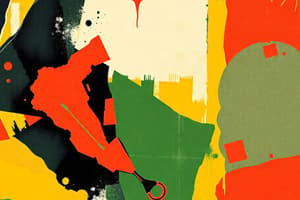Podcast
Questions and Answers
Which type of historical source became more prevalent between the thirteenth and fourteenth centuries?
Which type of historical source became more prevalent between the thirteenth and fourteenth centuries?
- Architecture
- Inscriptions
- Textual records (correct)
- Coins
During the thirteenth century, paper was more widely available than in the fourteenth century.
During the thirteenth century, paper was more widely available than in the fourteenth century.
False (B)
The gradual increase in the variety of __________ records during this period marked a significant change in historical sources.
The gradual increase in the variety of __________ records during this period marked a significant change in historical sources.
textual
What did scholars use to copy manuscripts before the invention of the printing press?
What did scholars use to copy manuscripts before the invention of the printing press?
Match the following terms with their descriptions:
Match the following terms with their descriptions:
Miniature paintings were often removed from manuscripts and sold separately.
Miniature paintings were often removed from manuscripts and sold separately.
What is a key challenge historians face when studying different manuscript versions of the same text?
What is a key challenge historians face when studying different manuscript versions of the same text?
What purpose did authors serve when they revised their chronicles?
What purpose did authors serve when they revised their chronicles?
The _______ style of handwriting is known for being cursive and easy to read.
The _______ style of handwriting is known for being cursive and easy to read.
Match the following manuscript practices with their descriptions:
Match the following manuscript practices with their descriptions:
Flashcards are hidden until you start studying
Study Notes
Historical Sources and Continuity
- Historians study the period from 700 to 1750 using sources like coins, inscriptions, architecture, and textual records.
- Increased variety of textual records emerged during this era, displacing other forms of information.
- Growing accessibility of paper facilitated the recording of texts such as holy scriptures, royal chronicles, and judicial records.
Value and Accessibility of Paper
- In the thirteenth century, paper was scarce; scholars often repurposed manuscripts for their needs.
- By the fourteenth century, paper became more widely available, even used casually for wrapping food.
- Manuscripts were collected by the wealthy and contained detailed records now housed in libraries and archives.
Manuscript Production and Copying
- Before the invention of the printing press, scribes manually copied texts, which led to unintended changes over time.
- Differences in handwriting styles, such as nastaliq and shikaste, complicated the reading and preservation of texts.
- Historians often compare multiple manuscript versions to determine the likely original content due to these variances.
Technological and Agricultural Innovations
- Significant technological advancements occurred during this period, including the Persian wheel for irrigation and the spinning wheel for weaving.
- Introduction of new crops, like potatoes, corn, chillies, tea, and coffee from various regions.
- These innovations were accompanied by diverse groups of people, fostering economic and cultural exchange.
Social Mobility and the Rajputs
- The subcontinent's wealth attracted mobile populations seeking opportunities for fortune.
- Rajputs, warriors claiming Kshatriya caste status, gained prominence between the eighth and fourteenth centuries.
- Rajputs were characterized by a chivalric code emphasizing valor and loyalty, praised by poets and bards.
Changes in Habitat and Lifestyle
- Ongoing agricultural expansion led to the gradual clearing of forests, causing some forest-dwellers to migrate.
- Some transitioned from foraging to farming, resulting in a new population of peasants who cultivated the land.
Studying That Suits You
Use AI to generate personalized quizzes and flashcards to suit your learning preferences.




